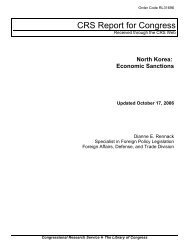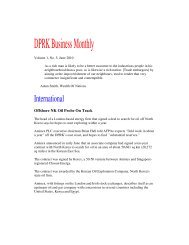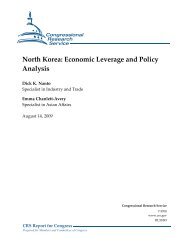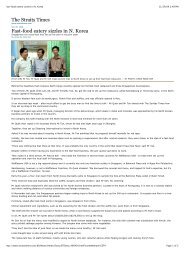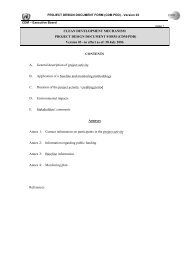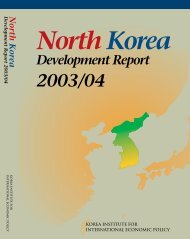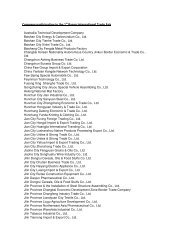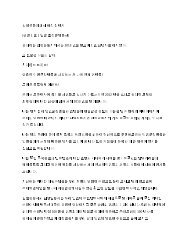North Korean Policy Elites - Defense Technical Information Center
North Korean Policy Elites - Defense Technical Information Center
North Korean Policy Elites - Defense Technical Information Center
You also want an ePaper? Increase the reach of your titles
YUMPU automatically turns print PDFs into web optimized ePapers that Google loves.
Each of the five papers in this collection takes its own approach to addressing the<br />
questions of what factions or potential factions exist among the <strong>North</strong> <strong>Korean</strong> elite, what<br />
information sources the elite use to learn about U.S. military initiatives, and what factors<br />
influence how outside information is perceived. It would be an exaggeration to say that the five<br />
viewpoints are as varied as the proverbial blind men’s descriptions of the elephant, but readers<br />
have surely noted differences as well as consistencies among the perspectives. For example, no<br />
two of the tables of <strong>North</strong> <strong>Korean</strong> elite purport to list exactly the same thing, and consequently<br />
no two can be directly compared. The differences in emphasis and approach to understanding<br />
<strong>North</strong> Korea point to the importance for U.S. policy makers of analyzing the behaviors of foreign<br />
leaders from multiple perspectives.<br />
A. WHO ARE THE NORTH KOREAN ELITE?<br />
<strong>North</strong> Korea’s elite can be defined in any number of ways, and as the country undergoes<br />
inevitable changes in its political and economic systems, the attributes that qualify one for elite<br />
membership may be changing as well. Bermudez conceptualizes the elite as the convergence of<br />
“five broad societal groupings: Kim Jong-il’s extended family and close confidants; the MPAF<br />
[Ministry of People’s Armed Forces]; the KWP [<strong>Korean</strong> Workers’ Party]; the cabinet; and the<br />
intelligence and internal security services,” with the “pinnacle of the power-holding elite” being<br />
the members of the National <strong>Defense</strong> Commission. Gause refers to the elite as a “class,” which<br />
paradoxically seems quite accurate in <strong>North</strong> Korea’s supposedly “classless” society. Hassig<br />
adopts a definition that emerged from the initial discussions of the research group, defining the<br />
elite broadly as “anyone who is in a channel of communication that leads upwards [to Kim Jongil].”<br />
Mansourov notes that party membership used to be the “entry ticket into the elite club,” but<br />
that under what he terms the “new nomenclature,” “access to state assets, prestige, and power,<br />
accumulation of private wealth, or government licensing authority is a must to qualify for the<br />
new elite status.” Mansourov argues that the people who are closest to Kim in the information<br />
chain are three generals in the KPA Supreme Command’s Operation Command Group. Smith<br />
endorses the idea that the elite consist of members of the topmost of the three political classes in<br />
<strong>North</strong> Korea - sometimes referred to in internal <strong>North</strong> <strong>Korean</strong> documents as the “core” class, but<br />
he also adds a concentric view of power: the “elite extends from Kim Jong-il’s inner<br />
circle - probably no more than a half dozen to ten people - through senior military, party and<br />
government officials, the middle ranks, out to, say, schoolteachers who instruct the children of<br />
the elite.”<br />
VI-1



